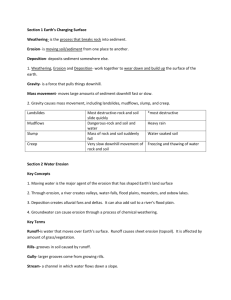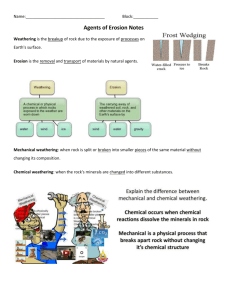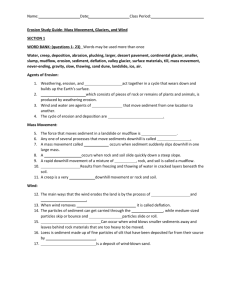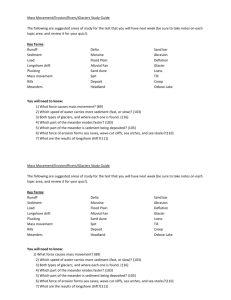5 Secret Agents of Erosion
advertisement
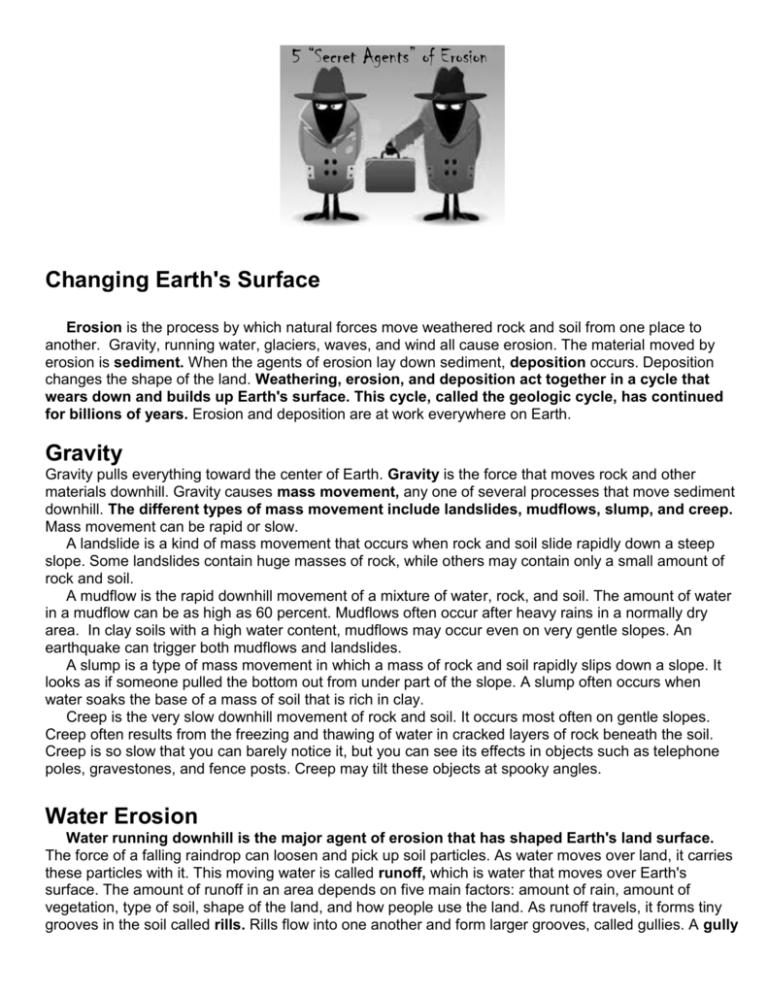
5 “Secret Agents” of Erosion Changing Earth's Surface Erosion is the process by which natural forces move weathered rock and soil from one place to another. Gravity, running water, glaciers, waves, and wind all cause erosion. The material moved by erosion is sediment. When the agents of erosion lay down sediment, deposition occurs. Deposition changes the shape of the land. Weathering, erosion, and deposition act together in a cycle that wears down and builds up Earth's surface. This cycle, called the geologic cycle, has continued for billions of years. Erosion and deposition are at work everywhere on Earth. Gravity Gravity pulls everything toward the center of Earth. Gravity is the force that moves rock and other materials downhill. Gravity causes mass movement, any one of several processes that move sediment downhill. The different types of mass movement include landslides, mudflows, slump, and creep. Mass movement can be rapid or slow. A landslide is a kind of mass movement that occurs when rock and soil slide rapidly down a steep slope. Some landslides contain huge masses of rock, while others may contain only a small amount of rock and soil. A mudflow is the rapid downhill movement of a mixture of water, rock, and soil. The amount of water in a mudflow can be as high as 60 percent. Mudflows often occur after heavy rains in a normally dry area. In clay soils with a high water content, mudflows may occur even on very gentle slopes. An earthquake can trigger both mudflows and landslides. A slump is a type of mass movement in which a mass of rock and soil rapidly slips down a slope. It looks as if someone pulled the bottom out from under part of the slope. A slump often occurs when water soaks the base of a mass of soil that is rich in clay. Creep is the very slow downhill movement of rock and soil. It occurs most often on gentle slopes. Creep often results from the freezing and thawing of water in cracked layers of rock beneath the soil. Creep is so slow that you can barely notice it, but you can see its effects in objects such as telephone poles, gravestones, and fence posts. Creep may tilt these objects at spooky angles. Water Erosion Water running downhill is the major agent of erosion that has shaped Earth's land surface. The force of a falling raindrop can loosen and pick up soil particles. As water moves over land, it carries these particles with it. This moving water is called runoff, which is water that moves over Earth's surface. The amount of runoff in an area depends on five main factors: amount of rain, amount of vegetation, type of soil, shape of the land, and how people use the land. As runoff travels, it forms tiny grooves in the soil called rills. Rills flow into one another and form larger grooves, called gullies. A gully is a large groove, or channel, in the soil that carries runoff after a rainstorm. Gullies join together to form streams. A stream is a channel along which water is continually flowing down a slope. Through erosion, a river creates valleys, waterfalls, flood plains, meanders, and oxbow lakes. A river's water has energy. Energy is the ability to do work or cause change. All along a river, the water's energy does work. Rivers often form on steep mountain slopes. There, a river generally follows a straight, narrow course, creating a deep, V-shaped valley. Lower down, a river usually flows over more gently sloping land. The river spreads out, forming a wide river valley. The flat, wide area of land along a river is a flood plain. A meander is a loop-like bend in the course of a river. Sometimes a meandering river forms an oxbow lake, a meander that has been cut off from the river. As water moves, it carries sediment with it. Whenever moving water slows down, it deposits sediment. Deposition creates landforms such as alluvial fans and deltas. It can also add soil to a river's flood plain. When a river flows out of a mountain valley, the water slows down. Then sediments are deposited in an alluvial fan, a wide, sloping deposit formed where a stream leaves a mountain range. A river ends when it flows into a still body of water, such as an ocean or a lake. There the water slows down and deposits sediment. This sediment builds up a landform called a delta. Deposition also occurs during floods. The ability of a river to cause erosion and carry sediment depends on several factors. A river is a dynamic system. A river's slope, volume of flow, and the shape of its streambed all affect how fast the river flows and how much sediment it can erode. The amount of sediment that a river carries is its load. Waves and Wind Ocean waves contain energy—sometimes a great deal of energy. The energy in waves comes from wind that blows across the water's surface. Waves are a major force of erosion along coasts. Waves shape the coast through erosion by breaking down rock and transporting sand and other sediment. When large waves hit the shore, their energy can break apart rocks. Waves also erode by abrasion. When a sediment-carrying wave hits land, the sediment wears away rock like sandpaper wearing away wood. The energy of incoming waves is concentrated on the headlands. A headland is a part of the shore that sticks out into the ocean. Over time, waves erode the headlands and even out the shoreline. Waves shape a coast when they deposit sediment, forming coastal features such as beaches, spits, sandbars, and barrier beaches. As waves reach the shore, they drop the sediment they carry, forming a beach. A beach is an area of wave-washed sediment along a coast. As angled waves repeatedly hit the beach, some of the beach sediment moves down the beach in a process called longshore drift. One result of longshore drift is the formation of a spit. A spit is a beach that projects like a finger out into the water. Spits occur where a headland or another obstacle interrupts longshore drift. Incoming waves carrying sand may build up sandbars, which are long ridges of sand parallel to shore. A barrier beach is similar to a sand bar. A sand dune is a deposit of wind-blown sand. Wind is the weakest agent of erosion. Yet wind can be a powerful force in shaping the land in areas where there are few plants to hold the soil in place. Wind causes erosion by deflation and abrasion. Geologists define deflation as the process by which wind removes surface materials. Deflation does not usually have a great effect on the land. In deserts, though, deflation can sometimes create an area of rock fragments called desert pavement. Abrasion by wind-carried sand can polish rock, but it causes little erosion. All sediment picked up by wind eventually falls to the ground. This happens when wind slows down or some obstacle, such as a boulder or clump of grass, traps the windblown sand and other sediment. Wind erosion and deposition may form sand dunes and loess deposits. Sand dunes can be seen on beaches and in deserts where windblown sediment has built up. Sediment that is finer than sand is sometimes deposited in layers far from its source. This fine, wind-deposited sediment is loess. Glaciers A glacier is any large mass of ice that moves slowly over land. There are two kinds of glaciers— continental glaciers and valley glaciers. A continental glacier is a glacier that covers much of a continent or large island. Today, continental glaciers cover about 10 percent of Earth's land, including Antarctica and most of Greenland. Continental glaciers can flow in all directions. Many times in the past, continental glaciers have covered large parts of Earth's surface. These times are known as ice ages. Beginning about 2.5 million years ago, continental glaciers advanced and retreated, or melted back, several times. They finally retreated about 10,000 years ago. A valley glacier is a long, narrow glacier that forms when snow and ice buildup high in a mountain valley. Valley glaciers are found on many high mountains. Glaciers can form only in an area where more snow falls than melts. Once the depth of snow and ice reaches more than 30 to 40 meters, gravity begins to pull the glacier downhill. Valley glaciers move, or flow, at a rate of a few centimeters to a few meters per day. Sometimes a valley glacier slides down more quickly in what is called a surge. The movement of a glacier changes the land beneath it. Although glaciers work slowly, they are a major force of erosion. The two processes by which glaciers erode the land are plucking and abrasion. As a glacier flows over the land, it picks up rocks in a process called plucking. Plucking can move even huge boulders. Many rocks remain on the bottom of a glacier, and the glacier drags them across the land. This process, called abrasion, gouges and scratches the bedrock. A glacier gathers huge amounts of rock and soil as it moves. When a glacier melts, it deposits the sediment it eroded from the land, creating various landforms. The mixture of sediments that a glacier deposits directly on the surface is called till. The till deposited at the edges of a glacier forms a ridge called a moraine. A terminal moraine is the ridge of till at the farthest point reached by a glacier. Retreating glaciers also create features called kettles. A kettle is a small depression that forms when a chunk of ice is left in glacial till. When the ice melts, the kettle remains. A kettle that is filled with water is called a kettle lake.

